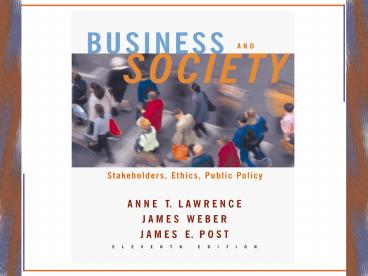Managing a Diverse Workforce PowerPoint PPT Presentation
1 / 14
Title: Managing a Diverse Workforce
1
(No Transcript)
2
Managing a Diverse Workforce
Chapter
19
- The Changing Face of the Workforce
- Gender and Race in the Workplace
- Governments Role in Securing Equal Employment
Opportunity - What Business Can Do Diversity Policies and
Practices - Balancing Work and Life
3
The changing face of the workforce
- Diversity
- Refers to variation in the important human
characteristics that distinguish people from one
another. - Workforce diversity trends
- More women are working than ever before.
- Immigration has profoundly reshaped the
workplace. - Ethnic and racial diversity is increasing.
- The workforce will continue to get older.
4
Proportion of women in the labor force
Figure 19.1
Percent
Year
5
The gender and race pay gap
Figure 19.2
6
Where women and minorities manage
Figure 19.3
- Percentage of Total, 2001
- Female Black Hispanic
- All occupations 46.6 11.3
10.9 - Managerial and professional 50.0
8.3 5.1 - Executive, administrative, and managerial
46.0 7.9
5.6 - Public officials and administrators
51.5 14.5 7.0 - Financial managers 52.1 6.6
4.2 - Personnel and labor relations managers
68.2 11.4 7.3 - Purchasing managers 42.6 8.9
4.3 - Marketing, advertising, public relations
mgrs. 39.3 3.7 4.3 - Educational administrators 64.1
11.5 5.7 - Health care managers 77.3 7.5
5.6 - Property and real estate managers 48.8
8.2 7.7 - Managementrelated occupations 58.6
9.7 5.7
7
Breaking the glass ceiling
- Although women and minorities are as competent as
white men in managing people and organizations,
they rarely attain the highest positions in
corporations. - In 2002, only 16 of executives were women.
- Only 12 of board members of Fortune 500 firms
were women in 2001. - Persons of color (men and women) now make up 19
of corporate directors.
8
Equal employment opportunity
- Discrimination based on race, color, religion,
sex, national origin, physical or mental
disability, or age is prohibited in all
employment practices. - Government contractors must have written
affirmative action plans detailing how they are
working positively to overcome past and present
effects of discrimination in their workforce. - Women and men must receive equal pay for
performing equal work, and employers may not
discriminate on the basis of pregnancy.
9
Major federal laws and executive orders
prohibiting job discrimination
Figure 19.4a
- Equal Pay Act (1963)Mandates equal pay for
substantially equal work by men and women. - Civil Rights Act (1964 amended 1972,
1991)Prohibits discrimination in employment
based on race, color, religion, sex, or national
origin. - Executive Order 11246 (1965)Mandates affirmative
action for all federal contractors and
subcontractors. - Age Discrimination in Employment Act
(1967)Protects individuals who are 40 years of
age or older.
10
Major federal laws and executive orders
prohibiting job discrimination
Figure 19.4b
- Equal Employment Opportunity Act (1972)Increases
power of the Equal Employment Opportunity
Commission to combat discrimination. - Pregnancy Discrimination Act (1978)Forbids
employers to discharge, fail to hire, or
otherwise discriminate against pregnant women. - Americans with Disabilities Act (1990)Prohibits
discrimination against individuals with
disabilities - Family and Medical Leave Act (1993)Requires
companies with 50 or more employees to provide up
to 12 weeks unpaid leave for illness, care of a
sick family member, or the birth or adoption of a
child.
11
Affirmative action
- Since the mid-1960s, major government contractors
have been required by presidential executive
order to adopt written affirmative action plans
specifying goals, actions, and timetables for
promoting greater on-the-job equality. - Their purpose is to reduce job discrimination by
encouraging companies to take positive steps to
overcome past employment practices and traditions
that may have been discriminatory. - Critics argue that affirmative action is
inconsistent with the principles of fairness and
equality. - In 1995, the Supreme Court ruled that affirmative
action laws were legal but only if they were
temporary and flexible.
12
Benefits of managing diversity
- Companies that promote equal employment
opportunity generally do better at attracting and
retaining workers from all backgrounds. - Businesses with employees from varied backgrounds
can often more effectively serve customers who
are themselves diverse. - The global marketplace demands a workforce with
language skills, cultural sensitivity, and
awareness of national and other differences
across markets. - Companies with effective diversity programs can
avoid costly lawsuits and damage to their
corporate reputations from charges of
discrimination or cultural insensitivity.
13
Diversity practices
- Actions taken by companies to manage diversity
effectively - They articulate a clear diversity mission, set
objectives, and hold managers accountable. - They spread a wide net in recruitment, to find
the most diverse possible pool of qualified
candidates. - They identify promising women and persons of
color, and provide them with mentors and other
kinds of support. - They set up diversity councils to monitor the
companys goals and progress toward them.
14
Family-friendly programs at General Mills
Exhibit 19.B
- An on-site infant care center.
- Flexible work arrangements.
- On-site health care services, including
mammograms for busy working mothers. - Emergency child care for parents whose regular
arrangements fall through. - Exercise classes offered at the companys health
and fitness center.

